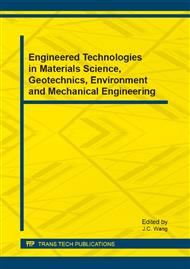[1]
Barni, M., et al.,"A DCT-domain system for robust image watermarking",Signal processing(Special Issue on Watermarking), 1998. 66(3): pp.357-372.
DOI: 10.1016/s0165-1684(98)00015-2
Google Scholar
[2]
J.Cox, I. and M. L.Miller, " A review of watermarking and the importance of perceptual modeling", Proc. of Electronic Imaging, 1997. 97: pp.92-99.
Google Scholar
[3]
Dorairangaswamy, M.A.,"A Robust Blind Image Watermarking Scheme in Spatial Domain for Copyright Protection", International Journal of Engineering and Technology, 2009. 1(3): pp.249-255.
DOI: 10.7763/ijet.2009.v1.47
Google Scholar
[4]
Li, L.D. and B.L. Guo, "Localized image watermarking in spatial domain resistant to geometric attacks", AEU-International Journal of Electronics and Communications, 2009. 63(2): pp.123-131.
DOI: 10.1016/j.aeue.2007.11.007
Google Scholar
[5]
Chiu, Y.C. and W.H. Tsai, "Copyright Protection by Watermarking for Color Images against Print-and-Scan Operations Using Coding and Synchronization of Peak Locations in Discrete Fourier Transform Domain", Journal of information science and engineering, 2006. 22(3): pp.483-496.
Google Scholar
[6]
Cheng, D., et al. "A Statistics-Based Watermarking Scheme Robust to Print-and-Scan", The International Symposium on Electronic Commerce and Security. 2008. Guangzhou, China. pp.894-898.
DOI: 10.1109/isecs.2008.68
Google Scholar
[7]
Dongcheng, S., Q. Wang, and L. Chao. "Digital watermarking algorithm for print-and-scan process used for printed matter anti-counterfeit", Congress on Image and Signal Processing (CISP '08). 2008. Sanya, China. pp.697-701.
DOI: 10.1109/cisp.2008.662
Google Scholar
[8]
Guo, C., et al. "A color image watermarking algorithm resistant to print-scan", IEEE International Conference on Wireless Communications, Networking and Information Security (WCNIS). 2010. Beijing, China. pp.518-521.
DOI: 10.1109/wcins.2010.5541833
Google Scholar
[9]
He, D. and Q. Sun. "A practical print-scan resilient watermarking scheme",The International Conference on Image Processing (ICIP). 2005. Genoa, Italy. pp.257-260.
DOI: 10.1109/icip.2005.1529736
Google Scholar
[10]
Lefebvre, F., et al. " A print and scan optimized watermarking scheme", The Fourth Workshop on Multimedia Signal Processing. 2001. Cannes France. pp.511-516.
DOI: 10.1109/mmsp.2001.962784
Google Scholar
[11]
Ahmed, N., T. Natarajan, and K.R. Rao, "Discrete cosine transform", IEEE Transactions on Computers, 1974. 100(1): pp.90-93.
DOI: 10.1109/t-c.1974.223784
Google Scholar
[12]
Avcıbas, I. and B. Sankur. "Statistical analysis of image quality measure", European Signal Processing Conference. 2000. Tampere,Finland. pp.2181-2184.
Google Scholar
[13]
Sheikh, H.R., M.F. Sabir, and A.C. Bovik, "A statistical evaluation of recent full reference image quality assessment algorithms", IEEE Transactions on Image Processing, 2006.15(11): pp.3440-3451.
DOI: 10.1109/tip.2006.881959
Google Scholar
[14]
Wang, Z., et al., "Image quality assessment: From error visibility to structural similarity", IEEE Transactions on Image Processing, 2004. 13(4): pp.600-612.
DOI: 10.1109/tip.2003.819861
Google Scholar


